#Wood Engraver's Network
Text
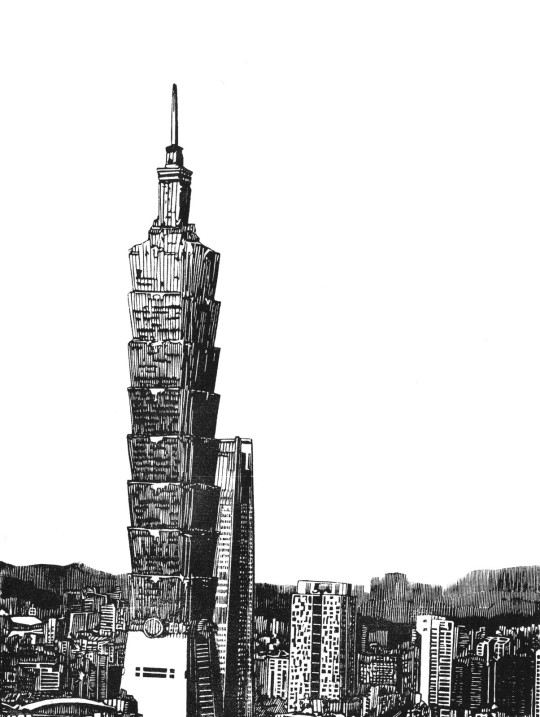
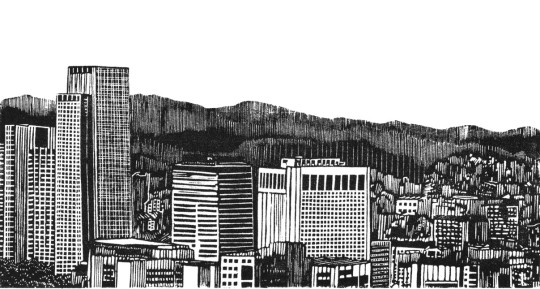


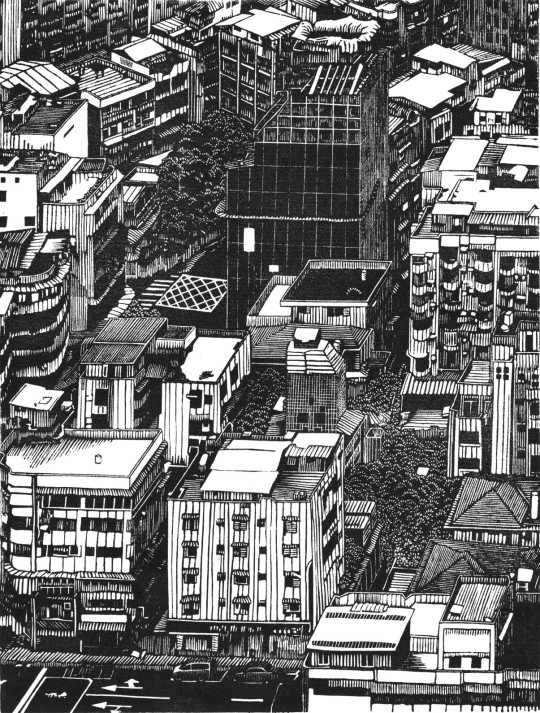


Wood Engraving Wednesday
LAWRENCE KEATY
In this wood engraving entitled Taipei, American artist Lawrence Keaty (b. 1986) offers us a vision of the city he was born in and where he lived when he made this print in 2020. The print is made from six separate blocks and together measure 65cm x 35cm (25.5" x 14"). The print was selected by my Wisconsin colleagues Tracy Honn and Jim Moran for inclusion in the Fourth Triennial Exhibition 2020-2022 of the American American wood engravers society, the Wood Engravers’ Network (WEN). This image is from the catalog for that travelling show.
Lawrence Keaty received a BA from Kenyon College with a major in Studio Art and he earned his MFA from Washington University in St. Louis in 2010. He taught English in Taiwan and South Korea from 2011 to 2019 and then worked as a writer/editor for Global Village Organization in Taipei for a year before returning to the U.S. (New Mexico) where he currently works as a UX/UI designer as well as a professional artist.
View other posts with engravings from the WEN Fourth Triennial Exhibition.
View more engravings by members of the Wood Engraver’s Network.
View more posts with wood engravings!
– MAX, Head, Special Collections and juror for the WEN Fifth Triennial Exhibition.
#Wood Engraving Wednesday#wood engravings#wood engravers#Lawrence Keaty#Taipei#Wood Engraver's Network#WEN#WEN Fourth Triennial Exhibition#exhibitions#exhibition catalogs
258 notes
·
View notes
Text
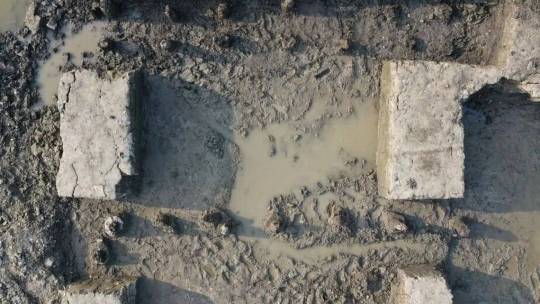
2,200-Year-Old Bronze Artifacts Uearthed in China
While exploring an ancient site in China, a team of archaeologists recently stumbled upon an abundant trove of ancient bronze objects dating back at least 2,200 years. Among their finds were plates, tripods, decorative ornaments — and a collection of swords.
Experts were exploring one of three sprawling sites in Shaoxing, officials from the Zhejiang Provincial Institute of Cultural Relics and Archaeology said, according to a Feb. 7 post from the Chinese Academy of Social Sciences. The three sites are known as Tingshan, Nanshantou and Nanshan.
The sites — and the ruins and artifacts found during excavations — date to China’s Spring and Autumn Period and the Warring States era, which lasted from 770 B.C. until about 221 B.C.
Archaeologists also found the ruins of a large building and other ancient remains while exploring the three sites. Here’s what they discovered.
SWORDS AND OTHER BRONZE ARTIFACTS
The seven swords and bronze artifacts were unearthed at the Nanshan site, officials said.
Of the seven swords, only three were completely preserved. Two fragments from the weapons had characters engraved on them, according to archaeologists.

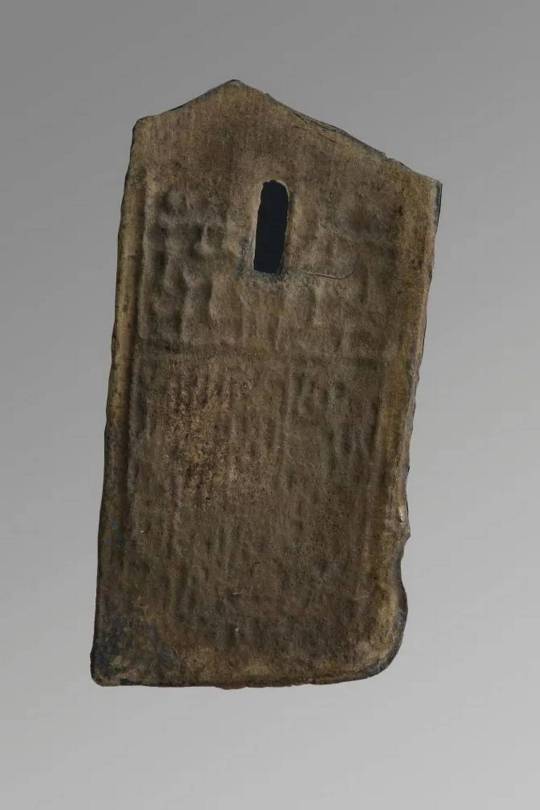
Experts also found pottery, porcelain, metalware, bamboo, wood artifacts, and plant and animal remains.
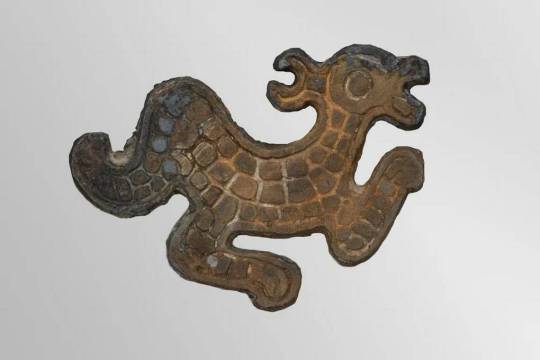
Among the animal remains, they found evidence of cattle, pigs, deer, fish and rare horses. There were also leftover grains and the remains of vegetables and fruits.
A LARGE CEREMONIAL BUILDING
At the Tingshan site, archaeologists found the ruins of what they believe was once a large ceremonial public building.
Experts unearthed part of the building’s foundation: an east-west wall spanning about 180 feet long and a north-south wall spanning about 30 feet wide.
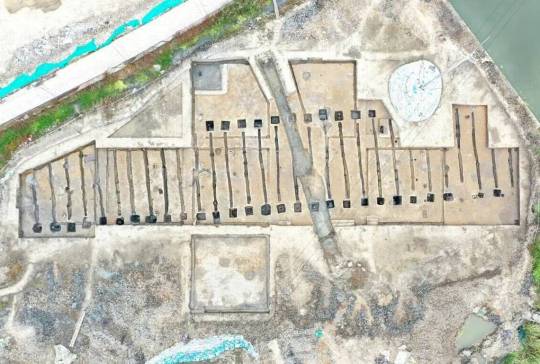
Whoever built the ancient structure likely dug the foundation’s trench and then placed a ground beam with attached columns into the trench, according to officials.

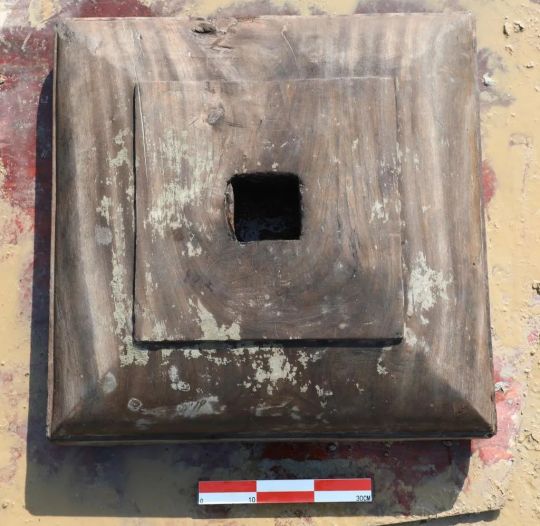
Archaeologists unearthed the building’s intricate column network, including exquisitely decorated and painted pillars.
AN ANCIENT WHARF AND SACRIFICIAL PIT
In another area of the Tingshan site, experts identified the ruins of an ancient wharf, known as the Linshui Wharf.
Archaeologists discovered three organized rows of wooden stakes left from the ancient dock-like structure.
They also found the remains of a sacrificial pit — still filled with offerings.
The pit held artifacts, including charcoal and food, according to officials.
Shaoxing is in the Zhejiang province in eastern China.
By MOIRA RITTER.
#2200-Year-Old Bronze Artifacts Uearthed in China#Shaoxing#Tingshan Nanshantou and Nanshan#Warring States era#Spring and Autumn Period#bronze#ancient artifacts#archeology#archeolgst#history#history news#ancient history#ancient culture#ancient civilizations#ancient china#chinese history#chinese art
34 notes
·
View notes
Text
Wei Wuxian’s Inventions Cause He’s a Mad Scientist & Deserves To Be a Happy Creator
technically part of the ghost king wwx series of posts but could also just be stuff in general. a lot is for protecting the yiling burial mounds and the people who live there. idek how long this is going to be so keep that in mind!
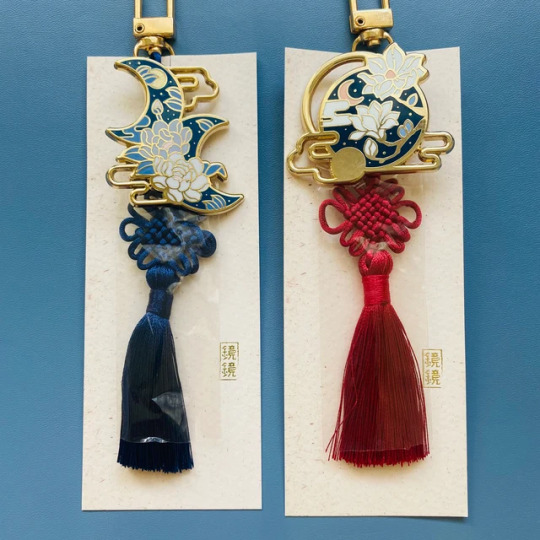
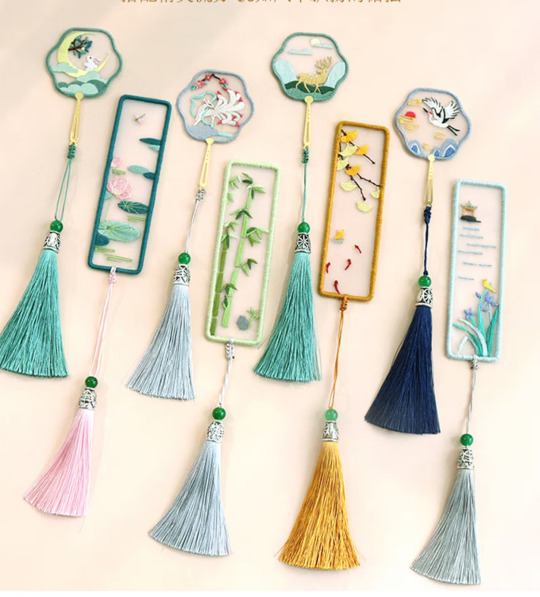
Sending stone - A raw quartz or amethyst crystal attached to a talisman-tag that tells the stone to vibrate in specific lengths and frequencies causing audible tones that can be used in specialised patterns to convey messages across certain networks. Sending networks are differentiated by the colour of the thread/rope/tassel used in the tag’s binding. It's essentially a morse-code group chat, looks like this picture but instead of metal it's engraved on wood or bamboo.
Spirit Binding Wraps - Cloth strips/bandages that are intricately sewn with a long continuous array that wraps around anything with a golden core, ending in an array that anchors into the ground and doesn’t let go. It's styled after a large snake and will only release after being fed resentful/yin energy. Expensive and arduous to make, as both the cloth and threads need to be soaked in either liquid resentment or Spirit Sapping Liquor, both of which can only be found (or made) in the burial mounds, and the repeating array must be embroidered to the correct lengths before the ending anchor array can be attached. Well worth the expense however, given so many orthodox cultivators are after the Yiling Wei residents. Like Xie Lian’s Rouye or Aizawa’s scarf but embroidered. It doesn’t work on non-cultivators or those who solely practise Guidao/demonic cultivation.
Bloodletting Buckets - Black bamboo buckets engraved with talismans that force any resentful energy in the contained liquid to coagulate into sludge at the bottom of the bucket, allowing residents to safely drink the burial mounds water without being a yin/yang cultivator.
Heart Binding Tattoo - A tattoo array over an individual’s heart that allows them to come and go through the barrier at the base of the mountain. Were someone to try and use a corpse with the tattoo to enter the mountain, the corpse would attack them. Made with Wen Qing, written in either Shizhoupian or Shuowen Jiezi, but I don't quite know witch.


Spirit Sapping Liquor - A derivative alcohol variant made in the burial mounds that eats spiritual/yang energy once consumed, travelling through the blood and clearing qi blockages within one’s meridians without touching the golden core (so long as one does not cultivate during the 3 day period that its active), and thus lessening chance of qi deviation. The resentment in the liquor can also be directed to eat poison from within a person by a talented Guidao practitioner (He Xuan, Hua Cheng, Wei Ying, Wen Qing, Wen Ning, even Qi Rong if he wanted).
Earthshifting Talismans - lets anyone stir up and loosen large areas of earth within a day, allowing less effort to be used when tilling or aerating soil, or digging cold storage basements. It's just kinda like putting a piece of land in the pear wiggler.
Hearth/Chill Box - a bamboo, wood, or stone box with engravings on the inside that keep it at a stable temperature, either hot or cold. Used to heat pre-made food, incubate eggs, build housing for chickens or other small animals, to heat water for bathing, to freeze meats, and make ice.
#mad scientist wei wuxian#uncle four and his alcohol obsession#ghost wei ying#ghost wei wuxian#mdzs#mxtx#tgcf#mxtx tgcf#mxtx mdzs#wwx#wen qing#mdzs x tgcf#calamity wei ying#calamity wei wuxian#wei wuxian#wei ying#ghost king wei ying#ghost king wei wuxian#yiling wei#yiling laozu#yiling patriarch#yiling burial mounds
36 notes
·
View notes
Text





last update 11/4/23
rajinikanth. 70. cis man. he/him. ┊┊ cerberus corp has been watching KINTAN NAIK. some of the public has dubbed them SAPROPHYTE because of FUNGUS MANIPULATION gifted by EATING SOMETHING HE SHOULDN’T HAVE. having been an extra ordinary since 1969, they’re doing a good job at hiding THAT HIS POWER IS WEAK TO FIRE. when they aren’t working their day job as a PHARMACEUTICAL COMPANY CEO, they are fond of SQUASH and are never seen without GOLD PLATED LIGHTER WITH THE WORDS ‘ALWAYS STAY HUMBLE’ ENGRAVED ON THE SIDE. at first glance they seem CHARMING & GENEROUS, though their underlings know them to also be MELODRAMATIC & ARROGANT. they consider themself a ANTI-HERO. ┊┊
001. GENERAL
name: kintan naik | nicknames: the general | age: 70 | date of birth: 1953 | zodiac answer | place of birth: - | current residence: manhattan | gender: cis man | pronouns: he/him | sexuality: gay | occupation: pharmaceutical company ceo | faceclaim: rajinikanth | height: 5'7" | tattoos: n/a | piercings: both ears
distinguishing features: reverse rogue x-men hair color (white on the sides, black in the center), large glasses, old man swagpositive traits: charming, intelligent, perceptive, friendlynegative traits melodramatic, arrogant, catty, manipulativelabels / tropes: the patriarch, cool old guy, evil old folks, benevolent boss, affluent ascetic, cool old guy, feeling their age, badass in a nice suit, man of wealth and taste, loveable rogue, affably evil. old wind bag, wise old folk facade
character inspiration: En (dorohedoro)
likes: positive press, being adored
dislikes: dips in the stock market, his kids disappointing him
fears: being forgotten, death
hobbies: the old rich guy classics: squash, golf, sailing, polo
habits: smoking, taking off his fashion eye glasses for dramatic effect
002. EXTRA ORDINARY
near death experience…
According to the About Page on his company’s website, Kintan Naik grew up in one of the poorest districts in western India. A born humanitarian, Kintan would fast for days so the other children in the orphanage he grew up in could eat their fill during meals. At age sixteen and desperate to provide for his found family, Kintan fearlessly traveled out into the nearby woods to forage for food. Fortuitously, he was able to find a large collection of mushrooms growing in the shade of a large tree. The dappled light from the sun above obscured the colors of the clusters of mushrooms and in his hunger and excitement, Kintan brought one of the plump, white caps to his lips and took a bite; it was both his greatest mistake and blessing.
In the end Kintan’s NDE allowed him to be able to feed not just his brothers and sisters at the orphanage but the other struggling people around him as well. Community food gardens grew into a thriving mushroom cultivating business that gave both nourishment and employment to the people around him. A born humanitarian, it was a no-brainier that Kintan would become a philanthropist once he accrued a mass of wealth.
Whether this story is one hundred percent true or not is up to debate, but it's not partially advisable that naysayers bring up their issues with Naik or his company in public or forums that can be tied back to them. As if there’s one thing that’s certain is that Kintan Naik has a knack for creating good press and has the sort of good will rarely shown to someone in his tax bracket.
power…
[ tw references to/mentions of bodily harm, body horror, gore, mutilation, suffocation ]
Kintan has absolute power over all types of fungi (mushrooms, mold, yeasts) and as such he can force them to rapidly go through their life cycle from spore to sporing in an instant. He can create/connect to mycelium underground networks and use the fruitbodies of mushrooms as wiretap devices.
His ability to manipulate air borne spores into full grown sporing mushrooms means that he can cause mushrooms to grow into a giant cluster. Mushrooms with toxic spores could be used to create poison clouds (Toxic Spore Bomb). And any spores breathed in/ingested could be forced into rapid growth and suffocate or explode someone from the inside out (Rapid Mushroom Growth/Infestation). He is also hypothetically able to make people ill by causing molds/yeast outbreaks in food/body parts.
[ /end of tw ]
drawbacks / vulnerabilities…
His ability works by essentially transferring his own energy into the fungi in question so he cannot grow them indefinitely. Once he becomes exhausted he can no longer use his power and in the case that he tires himself out he would need a couple days to recover. He can also not generate fungi out of thin air, he can only manipulate existing fungi.
As they are organic material, his power is weak to anything that can damage living things but particularly fire.
He's real old. 🤷♂️
The mycelium must be able to reasonably able to connect to each other whether they are rooted into the ground or able to spread far enough to connect to the network.
codename…
His marketing team came up with Saprophyte.
003. EXTRA
he has a gaggle of adopted children he's putting through saw-like sociopathic mind games to see which one is best suited to take over the family business once he retires
he is the face of many online memes that may or may not have been the work of his marketing and pr teams
has been time's person of the year
he caries small envelopes/baggies with different mushroom spores for emergency use.
he wears various rings with false gems that also contain spores but for particularly toxic fungi/fungi whose fruitbody grows extremely large (reserved for life-or-death situations).
003. CONNECTIONS:
The Royal Court:
Kintan's six children.
[ 4/6 roles reserved ]
Friends of the Family:
SONGSTRESS / HIMIKO YAMADA
The Court Jesters:
SAVANT / JAMES SAAB
RUBIX / JUNGHYUN HARVEY KWON
#cc.intro#cc.task#(if you see any typos in this no you didn't)#(i forgot to post this ahhhhh)#(will add more later etc etc)
9 notes
·
View notes
Text
'How well would your OCs do against a cockroach' Tag
Taking @touloserlautrec's open tag! I'll leave this an open tag too.
Winchester crew (TFA)
Dez: just watching it. Probably trying to identify it on the network. 0% concerned.
Syndy: ugh you have to smash these, they're bad news. [misses like five times and then manages to smash it into the engravings on her feet] Peeeteeeerrrrrrrrrrrrrr
Peter: it's okay I'll have these cleaned up in a sec. Oh look, there's another one. Let me-- oh, never mind, Tulip [his dog] just ate it.
Zel: believes the cockroach is too fast to squish, therefore it is, no matter how carefully she approaches it with a shoe (it would be Zalen's shoe if he ever wore anything that wasn't heels. This delicate procedure requires surface area).
Anni: chasing it around furniture trying to capture it in a glass while running through all the possible reasons there could be a cockroach??? in her house???
Julian: sighs and manages to stomp it on the first try.
Hoven: stares at it and wills it not to come any closer before he can make Julian deal with it.
Urma: climbs on the table and calls Anni.
Nicea crew
Declan: immediately decides this is above his pay grade and goes to find someone else to deal with it.
Cady: cockroach trapper extraordinaire. The cockroach is now living its best life over in the woods and it better stay there.
Rodney: he should do something about this. And he will. Probably. When he's done watching it in horror and not moving an inch.
Isabel: tries to smash it, misses, enters rage mode. It will not escape her. She will be waiting (and reasoning out whether she has brought the cockroach with her snack habits or it's unrelated).
Spinder: concocting a plan to hit it on the first try with whatever is closest to him, but it vanishes while he's thinking about it.
Tristan: not at all worried about getting up close and personal with the cockroach but still having a bad time trying to catch it or even squish it.
Tatya: in true cowgirl fashion, herds it out the door.
Bo: is anyone looking? No? They grab it off the wall and stuff it into their mouth.
Nicea taglist: @kahvilahuhut @kingkendrick7 @outpost51
#okay but the funniest iteration would be the Semilsstroms bc they're all gecko people#they have actual opinions about how cockroaches taste#Snap & Rolf are literally competing to see who gets to catch and eat it first. Rolf usually wins bc imbra#Vy (human) has to be thoroughly convinced that Wylie consuming raw cockroaches is not a hazard to her#cockroach battle tag game#tag games#wip: nicea#wip: tfa#c: Dez#c: Syndy#c: Peter#c: Zel#c: Anni#c: Julian#c: Hoven#c: Urma#c: Declan#c: Cady#c: Rodney#c: Isabel#c: Spinder#c: Tristan#c: Tatya#c: Bo
11 notes
·
View notes
Text
The Father of Forecast
After Captain Pringle Stokes committed suicide on the Beagle, Lieutenant Robert Fitzroy became her captain. In February 1829, his ship was blown onto the beams by a sudden violent gust. Only great seamanship saved the day, but two sailors were swept from the rigging and drowned. Immediately before the squall, the barometric pressure had dropped sharply, and Fitzroy's traumatic experience led him to wonder whether a more systematic means of predicting bad weather could not be devised.
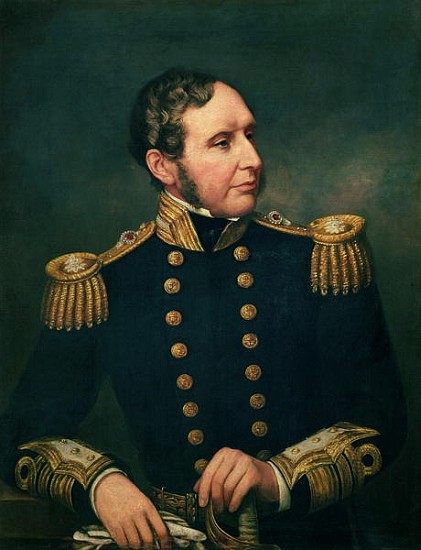
Vice Admiral Robert Fitzroy (1805-65), by Samual Lane,c. 1837 (x)
In 1845 he proposed distributing barometers along the British coast to give early warning of storms, but nothing came of it. In 1854, the Board of Trade established a meteorological department and Fitzroy was appointed its head. In 1857, Fitzroy, who was by then an admiral, designed a simple, sturdy Fishery Barometer (which soon became known as the Fitzroy Barometer), engraved with meteorological rhymes, such as "When the rise begins after the low, we expect storms and a clear wind."
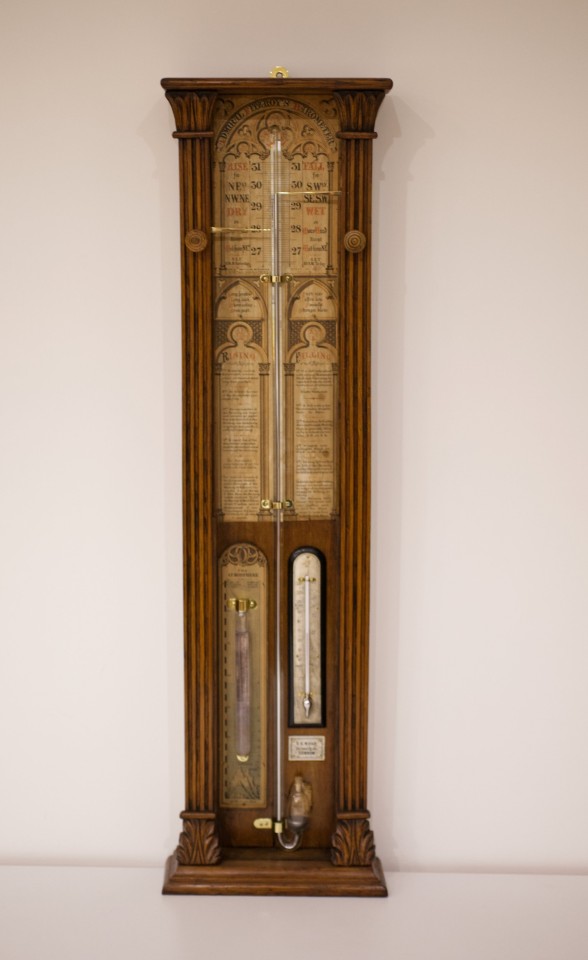
An Admiral Fitzroy Barometer by Eg Wood Of London, c. 1880 (x)
With the financial support of some philanthropists, he distributed 100 of these barometers to various maritime centres and life-saving stations. Despite his efforts, a well-preserved ship, the Royal Charter, sank in a storm off the Welsh coast in 1859, killing nearly 400 people. The tragedy led to a call for the Meteorological Department to expand its activities, not only collecting weather statistics but also using the new telegraph network to send storm warnings to coastal centres even when the storm was probably already underway. Fitzroy went further and expanded his department into a unit for making weather forecasts, a term he had coined in 1855.
By 1861, Fitzroy had established a comprehensive system for issuing weather information and storm warnings, which he coordinated from his London office. He then produced a daily weather forecast that was published in The Times - something no one had seriously attempted before. However, the forecasts inevitably attracted attention when they were wrong, and Fitzroy was publicly ridiculed and condemned in the House of Commons. In his efforts to improve the quality of his predictions, Fitzroy worked until he dropped.

This is the very first public weather forecast written in FitzRoy's own hand on the Daily Weather Report for 31st July 1861. It forecast the weather for the 1st and 2nd August. On the page Fitzroy notes that he believes the forecasts might be advantageously added to the observation information already published in the newspapers and if approved of he would continue them on similar principles.(x)
When he became numb and suffered from exhaustion, depression and the fact that he had been passed over for promotions on several occasions, Admiral Fitzroy committed suicide at his home in Surrey on 30 April 1865. It was a tragic echo of the fate of the captain of HMS Beagle, whose post he had taken over. When the Finisterre maritime area was renamed in 2002 to avoid confusion with the Spanish maritime area of the same name, the Meteorological Office chose the name Fitzroy in honour of its founder.
60 notes
·
View notes
Text
Top 5 Magnetic Name Badges You Need to Consider for Your Business
In the world of business, first impressions count for a lot. One way to make a positive and professional first impression is through the use of magnetic name badges.
Not only do these badges serve the practical purpose of identifying employees and staff members, but they also contribute to a cohesive and branded look for your business. If you're in the market for magnetic name badges, here are five top options to consider:
Classic Magnetic Name Badges
For a timeless and versatile option, classic Magnetic Name badges are an excellent choice. These badges typically feature a clear, durable plastic casing with a customisable paper insert where you can print the employee's name, title, and company logo.
The magnetic backing ensures a secure hold without the need for pins or clips, keeping clothing free from damage. Classic magnetic badges are cost-effective and can be ordered in bulk for larger businesses.
Premium Metal Magnetic Name Badges
For a more sophisticated and durable option, consider premium metal magnetic name badges. These badges are crafted from high-quality metals such as stainless steel or aluminium, giving them a polished and professional appearance.
The employee's details are typically engraved or printed onto the metal surface, creating a sleek and long-lasting finish. Metal magnetic badges convey a sense of prestige and are ideal for businesses where appearance is paramount.
Custom Shaped Magnetic Name Badges
To add a touch of uniqueness and creativity to your business branding, opt for custom-shaped magnetic name badges.
These badges can be cut into various shapes and sizes beyond the standard rectangle or oval, allowing you to create a badge that reflects your company's personality. Whether it's a logo-inspired shape or something entirely custom, these badges are sure to make a statement and leave a lasting impression on clients and customers.

Eco-Friendly Magnetic Name Badges
For businesses focused on sustainability and environmental responsibility, eco-friendly magnetic name badges are a great choice. These badges are made from recycled materials such as bamboo, wood, or recycled plastics, reducing their carbon footprint.
Despite their eco-friendly construction, these badges are durable and can be customised to showcase your brand effectively. Using eco-friendly magnetic name badges demonstrates your commitment to green practices and can resonate positively with environmentally conscious customers.
LED Light-Up Magnetic Name Badges
For businesses looking to add a fun and innovative twist to their employee identification, LED light-up magnetic name badges are a fantastic option.
These badges feature built-in LED lights that illuminate the employee's name and title, making them stand out in dimly lit environments such as networking events or trade shows. LED badges are available in various colours and can be programmed to flash or glow steadily, adding a touch of excitement to your business's visual presentation.
Choosing the Right Magnetic Name Badge for Your Business
When selecting magnetic name badges for your business, it's essential to consider factors such as your budget, branding requirements, and employee preferences. The right badge should align with your company's image and values while providing practical functionality for everyday use.
Before making a decision, evaluate different badge options based on their durability, customisation capabilities, and overall aesthetic appeal. Additionally, consider ordering samples to test the badges' magnetic strength and ensure they adhere securely to various types of clothing.
Investing in high-quality magnetic name badges not only enhances your business's professionalism but also contributes to a cohesive and unified brand identity. By choosing the right magnetic name badges, you can set the tone for positive interactions and leave a lasting impression on clients, customers, and business partners alike.
0 notes
Video
youtube
Друга књига Мојсијева-Излазак-ГЛАВА 38
CHAPTER 38 And he made the altar of burnt offering of shittim wood: five cubits was the length thereof, and five cubits the breadth thereof; it was foursquare; and three cubits the height thereof. 2 And he made the horns thereof on the four corners of it; the horns thereof were of the same: and he overlaid it with brass. 3 And he made all the vessels of the altar, the pots, and the shovels, and the basons, and the fleshhooks, and the firepans: all the vessels thereof made he of brass. 4 And he made for the altar a brasen grate of network under the compass thereof beneath unto the midst of it. 5 And he cast four rings for the four ends of the grate of brass, to be places for the staves. 6 And he made the staves of shittim wood, and overlaid them with brass. 7 And he put the staves into the rings on the sides of the altar, to bear it withal; he made the altar hollow with boards. 8 And he made the laver of brass, and the foot of it of brass, of the lookingglasses of the women assembling, which assembled at the door of the tabernacle of the congregation. 9 And he made the court: on the south side southward the hangings of the court were of fine twined linen, an hundred cubits: 10 Their pillars were twenty, and their brasen sockets twenty; the hooks of the pillars and their fillets were of silver. 11 And for the north side the hangings were an hundred cubits, their pillars were twenty, and their sockets of brass twenty; the hooks of the pillars and their fillets of silver. 12 And for the west side were hangings of fifty cubits, their pillars ten, and their sockets ten; the hooks of the pillars and their fillets of silver. 13 And for the east side eastward fifty cubits. 14 The hangings of the one side of the gate were fifteen cubits; their pillars three, and their sockets three. 15 And for the other side of the court gate, on this hand and that hand, were hangings of fifteen cubits; their pillars three, and their sockets three. 16 All the hangings of the court round about were of fine twined linen. 17 And the sockets for the pillars were of brass; the hooks of the pillars and their fillets of silver; and the overlaying of their chapiters of silver; and all the pillars of the court were filleted with silver. 18 And the hanging for the gate of the court was needlework, of blue, and purple, and scarlet, and fine twined linen: and twenty cubits was the length, and the height in the breadth was five cubits, answerable to the hangings of the court. 19 And their pillars were four, and their sockets of brass four; their hooks of silver, and the overlaying of their chapiters and their fillets of silver. 20 And all the pins of the tabernacle, and of the court round about, were of brass. 21 This is the sum of the tabernacle, even of the tabernacle of testimony, as it was counted, according to the commandment of Moses, for the service of the Levites, by the hand of Ithamar, son to Aaron the priest. 22 And Bezaleel the son of Uri, the son of Hur, of the tribe of Judah, made all that the LORD commanded Moses. 23 And with him was Aholiab, son of Ahisamach, of the tribe of Dan, an engraver, and a cunning workman, and an embroiderer in blue, and in purple, and in scarlet, and fine linen. 24 All the gold that was occupied for the work in all the work of the holy place, even the gold of the offering, was twenty and nine talents, and seven hundred and thirty shekels, after the shekel of the sanctuary. 25 And the silver of them that were numbered of the congregation was an hundred talents, and a thousand seven hundred and threescore and fifteen shekels, after the shekel of the sanctuary: 26 A bekah for every man, that is, half a shekel, after the shekel of the sanctuary, for every one that went to be numbered, from twenty years old and upward, for six hundred thousand and three thousand and five hundred and fifty men. 27 And of the hundred talents of silver were cast the sockets of the sanctuary, and the sockets of the vail; an hundred sockets of the hundred talents, a talent for a socket. 28 And of the thousand seven hundred seventy and five shekels he made hooks for the pillars, and overlaid their chapiters, and filleted them. 29 And the brass of the offering was seventy talents, and two thousand and four hundred shekels. 30 And therewith he made the sockets to the door of the tabernacle of the congregation, and the brasen altar, and the brasen grate for it, and all the vessels of the altar, 31 And the sockets of the court round about, and the sockets of the court gate, and all the pins of the tabernacle, and all the pins of the court round about.
0 notes
Text
Exodus
Chapter 38
1 And he made the altar of burnt offering of shittim wood: five cubits was the length thereof, and five cubits the breadth thereof; it was foursquare; and three cubits the height thereof.
2 And he made the horns thereof on the four corners of it; the horns thereof were of the same: and he overlaid it with brass.
3 And he made all the vessels of the altar, the pots, and the shovels, and the basons, and the fleshhooks, and the firepans: all the vessels thereof made he of brass.
4 And he made for the altar a brasen grate of network under the compass thereof beneath unto the midst of it.
5 And he cast four rings for the four ends of the grate of brass, to be places for the staves.
6 And he made the staves of shittim wood, and overlaid them with brass.
7 And he put the staves into the rings on the sides of the altar, to bear it withal; he made the altar hollow with boards.
8 And he made the laver of brass, and the foot of it of brass, of the lookingglasses of the women assembling, which assembled at the door of the tabernacle of the congregation.
9 And he made the court: on the south side southward the hangings of the court were of fine twined linen, an hundred cubits:
10 Their pillars were twenty, and their brasen sockets twenty; the hooks of the pillars and their fillets were of silver.
11 And for the north side the hangings were an hundred cubits, their pillars were twenty, and their sockets of brass twenty; the hooks of the pillars and their fillets of silver.
12 And for the west side were hangings of fifty cubits, their pillars ten, and their sockets ten; the hooks of the pillars and their fillets of silver.
13 And for the east side eastward fifty cubits.
14 The hangings of the one side of the gate were fifteen cubits; their pillars three, and their sockets three.
15 And for the other side of the court gate, on this hand and that hand, were hangings of fifteen cubits; their pillars three, and their sockets three.
16 All the hangings of the court round about were of fine twined linen.
17 And the sockets for the pillars were of brass; the hooks of the pillars and their fillets of silver; and the overlaying of their chapiters of silver; and all the pillars of the court were filleted with silver.
18 And the hanging for the gate of the court was needlework, of blue, and purple, and scarlet, and fine twined linen: and twenty cubits was the length, and the height in the breadth was five cubits, answerable to the hangings of the court.
19 And their pillars were four, and their sockets of brass four; their hooks of silver, and the overlaying of their chapiters and their fillets of silver.
20 And all the pins of the tabernacle, and of the court round about, were of brass.
21 This is the sum of the tabernacle, even of the tabernacle of testimony, as it was counted, according to the commandment of Moses, for the service of the Levites, by the hand of Ithamar, son to Aaron the priest.
22 And Bezaleel the son of Uri, the son of Hur, of the tribe of Judah, made all that the LORD commanded Moses.
23 And with him was Aholiab, son of Ahisamach, of the tribe of Dan, an engraver, and a cunning workman, and an embroiderer in blue, and in purple, and in scarlet, and fine linen.
24 All the gold that was occupied for the work in all the work of the holy place, even the gold of the offering, was twenty and nine talents, and seven hundred and thirty shekels, after the shekel of the sanctuary.
25 And the silver of them that were numbered of the congregation was an hundred talents, and a thousand seven hundred and threescore and fifteen shekels, after the shekel of the sanctuary:
26 A bekah for every man, that is, half a shekel, after the shekel of the sanctuary, for every one that went to be numbered, from twenty years old and upward, for six hundred thousand and three thousand and five hundred and fifty men.
27 And of the hundred talents of silver were cast the sockets of the sanctuary, and the sockets of the vail; an hundred sockets of the hundred talents, a talent for a socket.
28 And of the thousand seven hundred seventy and five shekels he made hooks for the pillars, and overlaid their chapiters, and filleted them.
29 And the brass of the offering was seventy talents, and two thousand and four hundred shekels.
30 And therewith he made the sockets to the door of the tabernacle of the congregation, and the brasen altar, and the brasen grate for it, and all the vessels of the altar,
31 And the sockets of the court round about, and the sockets of the court gate, and all the pins of the tabernacle, and all the pins of the court round about.
Exodus 38
Diane Beauford
0 notes
Text
What is Laser Engraving ? How to Build a Profitable Laser Engraving Business?
What is Laser Engraving?
Laser engraving is a process that uses a focused laser beam to permanently mark a material with a design or text. The laser beam vaporizes the material, creating a precise and durable engraving. Laser engraving can be used on a wide variety of materials, including wood, metal, glass, acrylic, and leather.
Step-by-Step Guide to Building a Profitable Laser Engraving Business:
1. Do Your Market Research:
Identify your target market and niche. Who are you going to sell your laser engraved products to? What types of products will you sell?
Research the competition in your area. What are other laser engraving businesses offering? How can you differentiate yourself?
Analyze the demand for laser engraved products in your area. Is there a growing demand for these products?
2. Create a Business Plan:
Define your business goals and objectives.
Develop a marketing strategy to reach your target market.
Create a financial forecast, including your startup costs and projected revenue.
Write a business plan to help you secure funding and stay on track.
3. Purchase the Right Equipment:
There are a variety of laser engraving machines on the market, so it's important to choose one that is right for your needs and budget.
Consider factors such as the laser power, engraving area, and ease of use.
You will also need software to create your designs and send them to the laser machine.
4. Set Up Your Workspace:
You will need a dedicated workspace that is well-ventilated and has a dust collection system.
You will also need a computer, design software, and safety equipment.
5. Create High-Quality Products:
Use high-quality materials and designs to create products that your customers will love.
Offer a variety of products and services to meet the needs of your target market.
Ensure that your products are priced competitively.
6. Market Your Business:
Develop a marketing strategy to reach your target market.
Use online and offline marketing channels to promote your business.
Network with other businesses and organizations in your community.
7. Provide Excellent Customer Service:
Go the extra mile to provide excellent customer service.
Be responsive to customer inquiries and requests.
Build relationships with your customers to encourage repeat business.
8. Grow Your Business:
Expand your product line and services as your business grows.
Consider opening a retail store or online store.
Franchise your business or sell licenses to use your technology.
Additional Tips:
Take advantage of online resources and training to learn more about laser engraving.
Join a laser engraving association or club to connect with other laser engravers.
Attend industry trade shows and events to learn about new trends and technologies.
Contact Chirag International to Buy Laser Engraving and Marking Machines:
Chirag International is a leading supplier of laser engraving and marking machines. They offer a wide variety of machines to meet the needs of any business. For more information, please visit their website or contact them directly.
#laserengraved#laserengraving#lasermarking#laser#startup#entrepreneur#business growth#branding#marketing#businessidea#businessideas
0 notes
Text
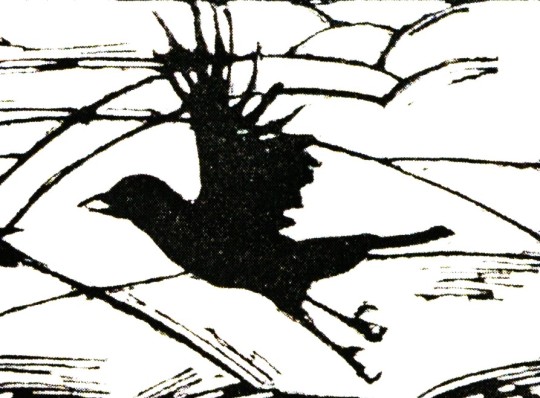
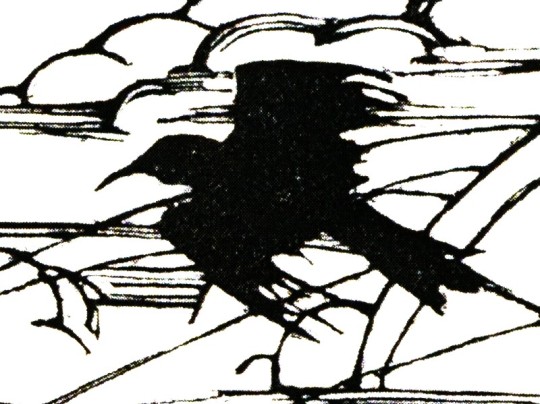


Yet Another Wood-engraved Feathursday
CINDY KOOPMAN
This 10 x 8 in (20.4 x 20.32 cm) wood engraving entitled Grasshopper (because, after all, there are some grasshoppers in it) by Minnesota artist Cindy Koopman is very reminiscent of our daily experience here in Special Collections. Every day, sometimes three or four times a day, the green roof outside our windows gets visited by a gang of 3-7 crows that investigate the undergrowth, jump and flutter about, toss random objects into the air, and on occasion actually take a slide down the solar panels on the roof just for fun! They are endlessly fascinating, and every day when they arrive all work stops in Special Collections and the entire staff line up along the windows to watch crows be crows for five minutes or so. It's just a part of our workday, but also one of its highlights.
Cindy Koopman is a Minnesota artist with an MFA in printmaking, and is a faculty member at Normandale Community College in Bloomington, MN. This print was selected for inclusion in the Fourth Triennial Exhibition 2020-2022 of the American wood engravers society, the Wood Engravers’ Network (WEN), and the image is from the catalog for that traveling show.

View more Feathursday posts.
View more posts with women wood engravers.
View other posts with engravings from the WEN Fourth Triennial Exhibition.
View more engravings by members of the Wood Engraver’s Network.
View more posts with wood engravings!
#Feathursday#Women's History Month#wood engravings#wood engravers#women wood engravers#Cindy Koopman#Grasshoppers#Crows#American Crow#Wood Engravers' Network#WEN#WEN Fourth Triennial Exhibition#exhibitions#exhibition catalogs#uwm special collections#birds#birbs!
64 notes
·
View notes
Text
Laser Engraving Machines
In the dynamic world of manufacturing and design, the evolution of Laser Engraving Machines has been nothing short of transformative. From humble beginnings as industrial tools for etching serial numbers and logos onto products, these machines have evolved into versatile platforms for creativity, precision, and innovation. Let's delve into the evolution of laser engraving machines and explore the diverse applications and possibilities they offer today.
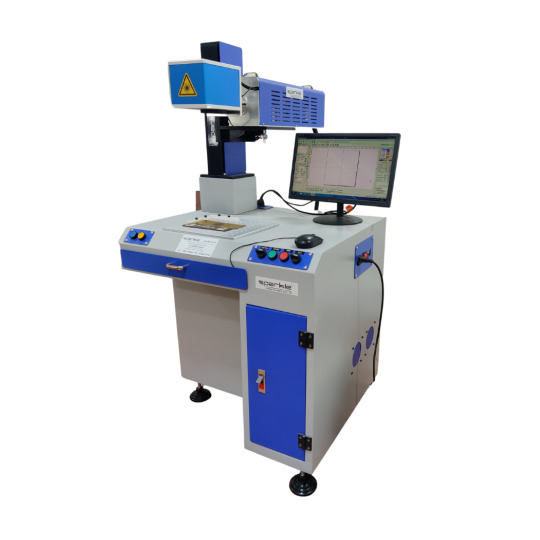
Enhanced Precision and Speed: Over the years, advancements in laser technology have led to significant improvements in engraving precision and speed. Modern laser engraving machines boast high-resolution optics, precise beam control, and rapid scanning capabilities, allowing for intricate designs and detailed engravings on various materials with unparalleled accuracy and efficiency.
Diverse Material Compatibility: One of the most remarkable aspects of modern laser engraving machines is their ability to work with a wide range of materials. From wood and acrylic to metal and glass, these machines can engrave, cut, and mark virtually any material with precision and consistency. This versatility opens up a world of possibilities for designers, craftsmen, and manufacturers alike.
Innovative Design Software Integration: The integration of innovative design software has revolutionized the capabilities of laser engraving machines. From industry-standard programs like Adobe Illustrator to specialized CAD/CAM software, designers have powerful tools at their disposal to create intricate designs, vector graphics, and 3D models for engraving. This seamless integration streamlines the design-to-production workflow, enabling faster prototyping and customization.
3D Engraving and Surface Texturing: The advent of 3D engraving technology has unlocked new dimensions of creativity and expression. Laser engraving machines can now create stunning three-dimensional effects, embossed textures, and sculptural details on various surfaces. Whether it's adding depth to signage, creating tactile surfaces on packaging, or replicating intricate artwork, 3D engraving pushes the boundaries of traditional engraving techniques.
Green and Sustainable Practices: As sustainability becomes increasingly important in manufacturing and design, laser engraving machines offer eco-friendly solutions. Unlike traditional engraving methods that produce waste and require harsh chemicals, laser engraving is a clean and energy-efficient process. With minimal material waste and low environmental impact, laser engraving aligns with green manufacturing practices and sustainable design principles.
Personalization and Customization Trends: In today's consumer-driven market, personalization and customization are key drivers of consumer engagement and loyalty. Laser engraving machines enable businesses to offer bespoke products, personalized gifts, and custom-branded merchandise that resonate with customers on a personal level. From monogrammed accessories to engraved photo albums, the ability to add a personal touch enhances the perceived value of products and fosters stronger connections with customers.
Integration with IoT and Industry 4.0: The integration of laser engraving machines with Internet of Things (IoT) technologies and Industry 4.0 initiatives is transforming manufacturing processes and supply chain management. By connecting engraving machines to networked systems, businesses can achieve real-time monitoring, predictive maintenance, and automated production scheduling. This connectivity enhances efficiency, reduces downtime, and optimizes resource utilization in the manufacturing ecosystem.
In conclusion, the evolution of laser engraving machines has been marked by continuous innovation, pushing the boundaries of precision, versatility, and sustainability. From enhancing design capabilities and enabling personalization to driving efficiency and connectivity in manufacturing, laser engraving machines are at the forefront of technological advancement. As we look to the future, the possibilities are limitless, and laser engraving machines will continue to play a central role in shaping the way we create, design, and manufacture in the years to come.
0 notes
Text
Exodus 38: Bezalel Starts Building the Altar of Burnt Offering
1 They built the altar of burnt offering of acacia wood, three cubits high; it was square, five cubits long and five cubits wide.
2 They made a horn at each of the four corners, so that the horns and the altar were of one piece, and they overlaid the altar with bronze.
3 They made all its utensils of bronze—its pots, shovels, sprinkling bowls, meat forks and firepans.
4 They made a grating for the altar, a bronze network, to be under its ledge, halfway up the altar.
5 They cast bronze rings to hold the poles for the four corners of the bronze grating.
6 They made the poles of acacia wood and overlaid them with bronze.
7 They inserted the poles into the rings so they would be on the sides of the altar for carrying it. They made it hollow, out of boards.
The Basin for Washing
8 They made the bronze basin and its bronze stand from the mirrors of the women who served at the entrance to the tent of meeting.
The Courtyard
9 Next they made the courtyard. The south side was a hundred cubits long and had curtains of finely twisted linen,
10 with twenty posts and twenty bronze bases, and with silver hooks and bands on the posts.
11 The north side was also a hundred cubits long and had twenty posts and twenty bronze bases, with silver hooks and bands on the posts.
12 The west end was fifty cubits wide and had curtains, with ten posts and ten bases, with silver hooks and bands on the posts.
13 The east end, toward the sunrise, was also fifty cubits wide.
14 Curtains fifteen cubits long were on one side of the entrance, with three posts and three bases,
15 and curtains fifteen cubits long were on the other side of the entrance to the courtyard, with three posts and three bases.
16 All the curtains around the courtyard were of finely twisted linen.
17 The bases for the posts were bronze. The hooks and bands on the posts were silver, and their tops were overlaid with silver; so all the posts of the courtyard had silver bands.
18 The curtain for the entrance to the courtyard was made of blue, purple and scarlet yarn and finely twisted linen—the work of an embroiderer. It was twenty cubits long and, like the curtains of the courtyard, five cubits high,
19 with four posts and four bronze bases. Their hooks and bands were silver, and their tops were overlaid with silver.
20 All the tent pegs of the tabernacle and of the surrounding courtyard were bronze.
The Materials Used
21 These are the amounts of the materials used for the tabernacle, the tabernacle of the covenant law, which were recorded at Moses’ command by the Levites under the direction of Ithamar son of Aaron, the priest.
22 (Bezalel son of Uri, the son of Hur, of the tribe of Judah, made everything the Lord commanded Moses;
23 with him was Oholiab son of Ahisamak, of the tribe of Dan—an engraver and designer, and an embroiderer in blue, purple and scarlet yarn and fine linen.)
24 The total amount of the gold from the wave offering used for all the work on the sanctuary was 29 talents and 730 shekels, according to the sanctuary shekel.
25 The silver obtained from those of the community who were counted in the census was 100 talents and 1,775 shekels, according to the sanctuary shekel—
26 one beka per person, that is, half a shekel, according to the sanctuary shekel, from everyone who had crossed over to those counted, twenty years old or more, a total of 603,550 men.
27 The 100 talents of silver were used to cast the bases for the sanctuary and for the curtain—100 bases from the 100 talents, one talent for each base.
28 They used the 1,775 shekels to make the hooks for the posts, to overlay the tops of the posts, and to make their bands.
29 The bronze from the wave offering was 70 talents and 2,400 shekels.
30 They used it to make the bases for the entrance to the tent of meeting, the bronze altar with its bronze grating and all its utensils,
31 the bases for the surrounding courtyard and those for its entrance and all the tent pegs for the tabernacle and those for the surrounding courtyard.
#Exodus ch.38#Holy Bible#Lord God Jehovah#Moses#Aaron#Bezalel#Oholiab#Orders#Instructions#Israelites#Altar#Burnt Offering#Basin#Courtyard#Materials#Used#Horns#Bronze#Gold#Silver#Rings#Tent of Meeting#Bases#Hooks#Posts#Bands#Linens#Tabernacle#Covenant Law#Ithamar
0 notes
Text
CNC Blog
Success Technologies CNC Blog is a network-based platform for free discussion of CNC machining, with authors or experts writing professional articles on CNC routers, CNC mills, CNC drills, CNC lathes, laser cutters, laser engravers, laser welders, laser cleaners, plasma cutters, edge banders, wood sanders, and digital cutters.
You will get helpful content from the most professional blog posts and the most popular articles, including FAQs, user manuals, solutions, stories, projects, ideas, guides, software, hardware, history, trends, news and events, as well as "how to" guidelines on making, building, and DIY plans for all types of CNC machines.
0 notes
Photo
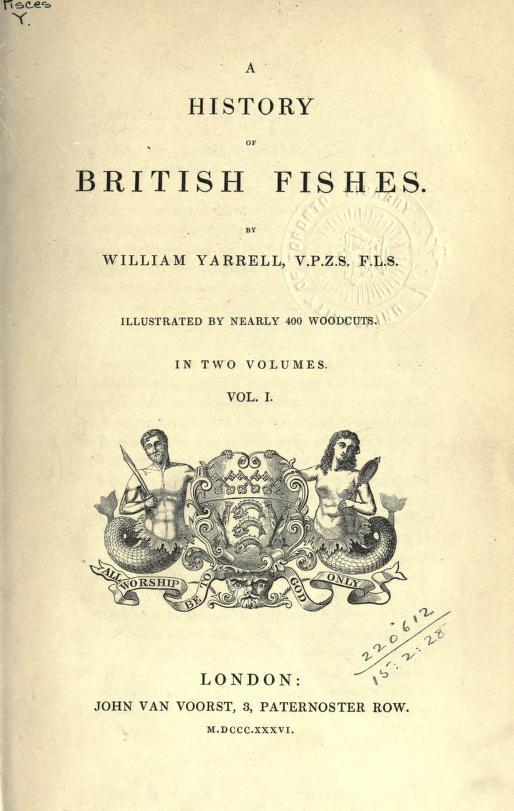
A History of British Fishes is a natural history book by William Yarrell, first serialised in 19 parts from 1835, and then published bound in two volumes in 1836. It is a handbook or field guide systematically describing every type of fish known to occur in the British Isles, with an article for each species.
Yarrell was a London bookseller and newsagent with the time and income to indulge his interest in natural history. He was a prominent member of several natural history societies and knew most of the leading British naturalists of his day. He was able to draw on his own extensive library and collection of specimens, his wide network of like-minded naturalist friends and his access to major libraries to garner material for his writings, the most important of which were A History of British Fishes and the 1843 A History of British Birds.
A History of British Fishes followed the example of Thomas Bewick's natural history books in its combination of up-to-date scientific data, accurate illustrations, detailed descriptions and varied anecdotes. The wood engraving illustrations were drawn by Alexander Fussell and engraved by John Thompson; three editions and their two supplements were published by John Van Voorst's company, based in Paternoster Row, London. Yarrell died in 1856, and the third edition was produced posthumously. The book was a commercial success and became the standard reference work for a generation of British ichthyologists. Yarrell's name is commemorated in eight species, three of which are fish, and in the lightfish genus Yarrella.
https://en.wikipedia.org/wiki/A_History_of_British_Fishes
0 notes
Text
Smart laser cutter system detects different materials
Smart laser cutter system detects different materials
With the addition of computers, laser cutters have rapidly become a relatively simple and powerful tool, with software controlling shiny machinery that can chop metals, woods, papers, and plastics. While this curious amalgam of materials feels encompassing, users still face difficulties distinguishing between stockpiles of visually similar materials, where the wrong stuff can make gooey messes, give off horrendous odors, or worse, spew out harmful chemicals.Get more news about laser cutting line,you can vist our website!
Addressing what might not be totally apparent to the naked eye, scientists from MIT’s Computer Science and Artificial Intelligence Laboratory (CSAIL) came up with “SensiCut,” a smart material-sensing platform for laser cutters. In contrast to conventional, camera-based approaches that can easily misidentify materials, SensiCut uses a more nuanced fusion. It identifies materials using deep learning and an optical method called “speckle sensing,” a technique that uses a laser to sense a surface’s microstructure, enabled by just one image-sensing add-on.
A little assistance from SensiCut could go a long way — it could potentially protect users from hazardous waste, provide material-specific knowledge, suggest subtle cutting adjustments for better results, and even engrave various items like garments or phone cases that consist of multiple materials.
“By augmenting standard laser cutters with lensless image sensors, we can easily identify visually similar materials commonly found in workshops and reduce overall waste,” says Mustafa Doga Dogan, PhD candidate at MIT CSAIL. “We do this by leveraging a material’s micron-level surface structure, which is a unique characteristic even when visually similar to another type. Without that, you’d likely have to make an educated guess on the correct material name from a large database.” Beyond using cameras, sticker tags (like QR codes) have also been used on individual sheets to identify them. Which seems straightforward, however, during laser cutting, if the code is cut off from the main sheet, it can’t be identified for future uses. Also, if an incorrect tag is attached, the laser cutter will assume the wrong material type.
To successfully play a round of “what material is this,” the team trained SensiCut’s deep neural network on images of 30 different material types of over 38,000 images, where it could then differentiate between things like acrylic, foamboard, and styrene, and even provide further guidance on power and speed settings.
In one experiment, the team decided to build a face shield, which would require distinguishing between transparent materials from a workshop. The user would first select a design file in the interface, and then use the “pinpoint” function to get the laser moving to identify the material type at a point on the sheet. The laser interacts with the very tiny features of the surface and the rays are reflected off it, arriving at the pixels of the image sensor and producing a unique 2-D image. The system could then alert or flag the user that their sheet is polycarbonate, which means potentially highly toxic flames if cut by a laser.
The speckle imaging technique was used inside a laser cutter, with low-cost, off-the shelf-components, like a Raspberry Pi Zero microprocessor board. To make it compact, the team designed and 3-D printed a lightweight mechanical housing.
Beyond laser cutters, the team envisions a future where SensiCut’s sensing technology could eventually be integrated into other fabrication tools like 3-D printers. To capture additional nuances, they also plan to extend the system by adding thickness detection, a pertinent variable in material makeup.
Dogan wrote the paper alongside undergraduate researchers Steven Acevedo Colon and Varnika Sinha in MIT's Department of Electrical Engineering and Computer Science, Associate Professor Kaan Akşit of University College London, and MIT Professor Stefanie Mueller.
0 notes